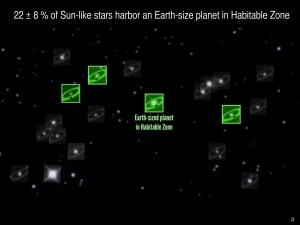
 One in Five Stars Has Earth-Size Planet in Habitable Zone —
One in Five Stars Has Earth-Size Planet in Habitable Zone —
Scientists from University of California, Berkeley, and University of Hawaii, Manoa, have statistically determined that twenty percent of Sun-like stars in our galaxy have Earth-size planets that could host life. The findings, gleaned from data collected from NASA’s Kepler spacecraft and the W. M. Keck Observatory, now satisfy Kepler’s primary mission: to determine how many of the 100 billion stars in our galaxy have potentially habitable planets. The results were published November 4 in the journal Proceedings of the National Academy of Sciences.
“What this means is, when you look up at the thousands of stars in the night sky, the nearest sun-like star with an Earth-size planet in its habitable zone is probably only 12 light years away and can be seen with the naked eye. That is amazing,” said UC Berkeley graduate student Erik Petigura, who led the team analyzing the Kepler and Keck Observatory data.
The team, which also included planet hunter Geoffrey Marcy, UC Berkeley professor of astronomy, cautioned that Earth-size planets in Earth-size orbits are not necessarily hospitable to life, even if they orbit in the habitable zone of a star where the temperature is not too hot and not too cold.
“Some may have thick atmospheres, making it so hot at the surface that DNA-like molecules would not survive. Others may have rocky surfaces that could harbor liquid water suitable for living organisms,” Marcy said. “We don’t know what range of planet types and their environments are suitable for life.”
NASA launched the now crippled Kepler space telescope in 2009 to look for planets that cross in front of, or transit, their stars, causing a slight diminution—about one hundredth of one percent—in the star’s brightness. From among the 150,000 stars photographed every 30 minutes for four years, NASA’s Kepler team reported more than 3,000 planet candidates. Many of these are much larger than Earth—ranging from large planets with thick atmospheres, like Neptune, to gas giants like Jupiter—or in orbits so close to their stars that they are roasted.
To sort them out, Petigura and his colleagues are using the twin 10-meter telescopes of the Keck Observatory on the summit of Mauna Kea, Hawaii, to obtain spectra of as many stars as possible. This will help them determine each star’s true brightness and calculate the diameter of each transiting planet, with an emphasis on Earth-size worlds.
The team focused on the 42,000 stars that are like the sun or slightly cooler and smaller, and found 603 candidate planets orbiting them. Only 10 of these were Earth-size, that is, one to two times the diameter of Earth and orbiting their star at a distance where they are heated to lukewarm temperatures suitable for life. The team’s definition of habitable is that a planet receives between four times and one-quarter the amount of light that Earth receives from the sun.
“The primary goal of the Kepler mission was to answer the question, When you look up in the night sky, what fraction of the stars that you see have Earth-size planets at lukewarm temperatures so that water would not be frozen into ice or vaporized into steam, but remain a liquid—because liquid water is now understood to be the prerequisite for life,” Marcy said. “Until now, no one knew exactly how common potentially habitable planets were around Sun-like stars in the galaxy.”


Be the first to comment